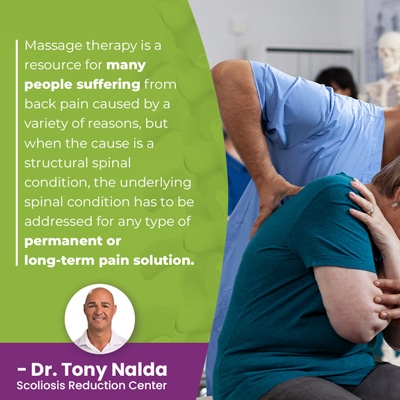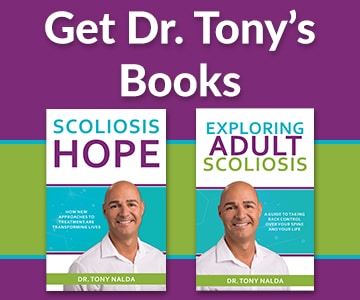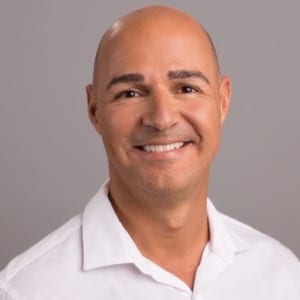Scoliosis Massage: Is It an Effective Treatment for Pain Relief?

Scoliosis massage therapy can help relax strained muscles to relieve muscle pain, but the effects are mainly felt during the massage and in the immediate days following. For permanent long-term scoliosis pain relief, therapeutic massage therapy is limited in what it can deliver.
The most effective treatment for pain relief is proactive treatment that addresses the underlying cause of the pain: the condition itself. Massage therapy can help relax muscle tissue and strained muscles for short-term pain relief, but only treatment can provide an effective long-term solution.
Before exploring scoliosis massage therapy as a potential treatment option, let's start with how scoliosis can affect the muscles.
Table of Contents
Scoliosis and Muscle Health
Scoliosis is a spinal condition, but its effects can be widespread throughout the body.
The condition causes an unnatural sideways-bending spinal curvature that also rotates to develop, and as a progressive condition, its nature is to get more severe over time.
There are never treatment guarantees, but in most cases, the sooner treatment is started, the better.
There are two main treatment approaches for scoliosis including surgical spinal fusion and conservative nonsurgical treatment options.
Scoliosis ranges widely in severity from mild scoliosis to moderate scoliosis, severe and very severe cases, and there are different types with unique characteristics and treatment needs.
So no two cases are the same. Effects one patient experiences doesn't always indicate what others will face, which is why treatment plans need to be fully customized around important patient/condition variables.
Scoliosis doesn't just affect the spine, but also its surrounding nerves and muscles.
 Scoliosis causes the spine to become misaligned due to the condition's uneven forces, and if the spine is out of balance, the body is too, including its muscles.
Scoliosis causes the spine to become misaligned due to the condition's uneven forces, and if the spine is out of balance, the body is too, including its muscles.
Muscular Imbalance
A potential effect of scoliosis is a muscular imbalance.
Scoliosis can cause the muscles on one side of the spine to become weak from lack of use and the muscles on the other side to become stretched and sore from overuse; the spine's unnatural bend and twist can pull its surrounding muscles in different directions.
As mentioned, there are different types of scoliosis, and type is determined by causation.
In the majority of scoliosis cases, approximately 80 percent, they have no known causes and are classified as idiopathic scoliosis, and the remaining 20 percent are associated with known causes, are considered atypical, and can be particularly severe: neuromuscular scoliosis, congenital scoliosis, and degenerative scoliosis.
In typical cases of idiopathic scoliosis, curves bend to the right, away from the heart, but in atypical cases, curves can bend to the left, towards the heart, and this makes them particularly complex to treat because there is an underlying pathology involved.
Neuromuscular scoliosis is caused by the presence of a larger neuromuscular condition like spina bifida, muscular dystrophy, or cerebral palsy.
Congenital scoliosis is caused by a malformed spine that develops in utero, so babies are born with the condition.
Degenerative scoliosis is caused by natural age-related spinal degeneration.
Curve Direction and Muscle Weakness
So in typical cases with right-bending curves, the muscles on the right side of the spine are working harder to stabilize the spine, so they tend to be stronger and more stretched; muscles on the left side of a typical dextroscoliosis curve can become weaker and tighter because they are not being used as much.
Once an imbalance develops anywhere inside the body, including the muscles, it can get worse if left unaddressed, especially when it's caused by a progressive condition like scoliosis.
The longer a muscular imbalance is left unaddressed, the harder it is to improve and/or reverse; this is the case with most condition effects.
Massage Therapy and Scoliosis Muscle Pain
When there is a muscular imbalance and postural changes caused by scoliosis, pain can involve the muscles, the back, and nerve pain.
Muscle pain can involve sore and stretched muscles, weak muscles, muscle spasms, and a muscular imbalance.
 Massage therapy is a resource for many people suffering from back pain caused by a variety of reasons, but when the cause is a structural spinal condition, the underlying spinal condition has to be addressed for any type of permanent or long-term pain solution.
Massage therapy is a resource for many people suffering from back pain caused by a variety of reasons, but when the cause is a structural spinal condition, the underlying spinal condition has to be addressed for any type of permanent or long-term pain solution.
The underlying nature of scoliosis is a structural abnormality within the spine itself, so only treatment that can alter the spine's structure can actually treat related pain.
So while massage therapy and a deep tissue massage can help scoliosis patients relax tight muscles and deep spinal musculature, this won't alter the underlying cause, the condition's uneven forces caused by the spine's misalignment.
So a qualified massage therapist who specializes in scoliosis-specific massage can help relieve muscle stiffness and related muscle pain, and relaxing strained muscles and muscle tissues can also help with muscle cramps and muscle stimulation of muscles that are becoming weak from lack of use.
Muscle asymmetry needs to be addressed as one level of the condition's effects, and when it comes to permanent solutions, we're talking about a comprehensive and customized treatment plan that can improve the condition's structural nature and effects, which involve muscle health.
Scoliosis Treatment for Unbalanced and Sore Muscles
There is a big difference between treating a condition's symptoms and addressing their underlying cause.
When it comes to addressing a scoliosis muscular imbalance, this means addressing its underlying cause: the uneven forces of scoliosis.
The main effects of scoliosis in children involve postural changes such as uneven shoulders, shoulder blades, hips, development of a rib cage arch, and more, and these types of changes also cause disruptions to balance, coordination, and gait.
Here at the Scoliosis Reduction Center®, conservative treatment is applied that's proactive and effective, particularly with early detection and intervention.
The important thing to understand about a number of potential condition effects, including the development of a muscular imbalance, is that many of them can be prevented by working towards preventing progression.
The condition's effects get worse as the size of the unnatural spinal curve increases, along with the condition's effects.
Scoliosis symptoms that involve the muscles are targeted through a multifaceted treatment approach that combines condition-specific chiropractic care, physical therapy, corrective bracing, and rehabilitation.
As such a complex condition, no one form of treatment is enough to impact conditions on every level, but when the power of different facets of treatment are combined, they can complement one another and impact conditions on every level from improving the spine's structural alignment and improving the spine's surrounding muscle balance and strength.
Physical Therapy and Scoliosis Exercises
When it comes to improving the spine's surrounding muscle strength and balance, this also means improving the support and stability they can offer the spine.
So part of supporting structural changes worked towards through chiropractic care to reduce curve size and improve the spine's alignment is to improve the spine's surrounding muscle health.
Poor posture is a main effect of scoliosis, and physical therapy and scoliosis-specific exercises can also improve posture through the use of mirror image exercises that teach postural awareness and remodeling.
This type of exercise program teaches patients the specific types of exercises to do at home to counteract their condition's effects, and knowing how to hold their spines and bodies during movement can mean better posture and body positioning in their daily lives.
Scoliosis related pain can include muscle imbalances, sore muscles, muscle tension, and muscle tightness, and a deeper connective tissue massage can help with alleviating discomfort, but this doesn't mean the cause of the pain is being treated; massage therapy for scoliosis is more about short-term pain relief.
Conclusion
Spinal health is important for a number of reasons, one of which involves practicing good posture and body positioning.
Scoliosis introduces a lot of uneven forces to the spine and its surroundings, including the core and back muscles, and while massage therapy can't treat scoliosis, integrating massage therapy into a proactive conservative treatment plan can help with relaxing sore muscles to make them more responsive to treatment.
There are a number of massage techniques offered, and while regular massage therapy can offer little in terms of therapeutic benefits, a massage therapist who's familiar with the complexities of a scoliotic spine and scoliosis management, can help alleviate pain for temporary relief.
Asymmetrical muscles caused by scoliosis can't be improved by massage therapy, but as body alignment is addressed alongside the spine's unnatural spinal curve, the body's overall symmetry, including its muscles, can also be improved.
Dr. Tony Nalda
DOCTOR OF CHIROPRACTIC
After receiving an undergraduate degree in psychology and his Doctorate of Chiropractic from Life University, Dr. Nalda settled in Celebration, Florida and proceeded to build one of Central Florida’s most successful chiropractic clinics.
His experience with patients suffering from scoliosis, and the confusion and frustration they faced, led him to seek a specialty in scoliosis care. In 2006 he completed his Intensive Care Certification from CLEAR Institute, a leading scoliosis educational and certification center.
About Dr. Tony Nalda
 Ready to explore scoliosis treatment? Contact Us Now
Ready to explore scoliosis treatment? Contact Us Now





